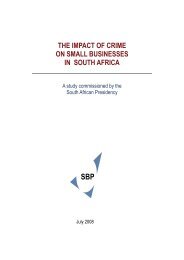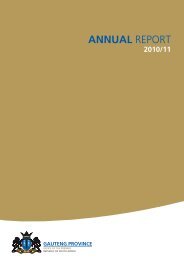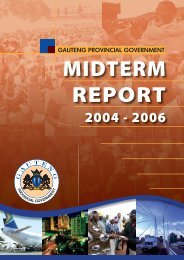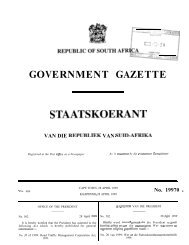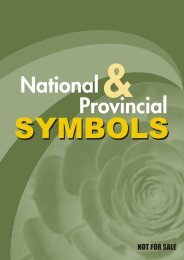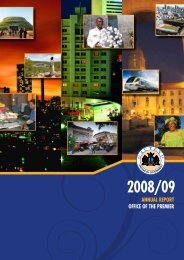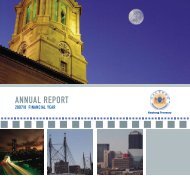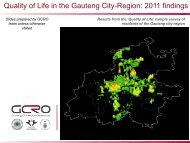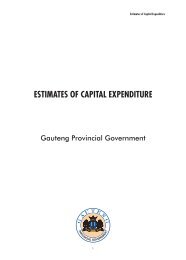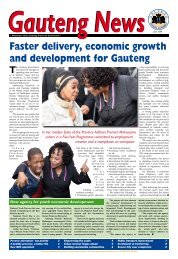the gauteng spatial development framework - Gauteng Online
the gauteng spatial development framework - Gauteng Online
the gauteng spatial development framework - Gauteng Online
You also want an ePaper? Increase the reach of your titles
YUMPU automatically turns print PDFs into web optimized ePapers that Google loves.
Brownfield Land and SitesPreviously developed land which is no longer occupied by <strong>the</strong> previous use, often leavingbehind vacant permanent structures, and any associated fixed surface infrastructure. Itoften constitutes abandoned or under-utilised sites within <strong>the</strong> built-up urban area, (suchas hazardous industry, manufacturing, utilities, etc.) and available for re<strong>development</strong>.Buffer ZoneAn area of land separating certain types of <strong>development</strong> from adjoining sensitive land usesto minimise negative impacts. These zones are often used in relation to minerals and/orwaste <strong>development</strong>. Buffer zones are usually a landscaped open area, designed to separateincompatible land uses. A loosely used term that describes any zone used to separate andprovide transition between two o<strong>the</strong>r zones, which are incompatible.CCentral Business District (CBD)The traditional business core of an urban area, characterized by a high concentration ofactivity within a relatively small area. The CBD is usually <strong>the</strong> office, financial, retail andservice centre of a city, providing both employment opportunities for a large number ofpeople and a significant share of <strong>the</strong> tax base.Character ZoneA term relating to Conservation Areas or Listed Buildings, but also to <strong>the</strong> appearance ofany rural or urban location in terms of its landscape or <strong>the</strong> layout of streets and open spaces,often giving places <strong>the</strong>ir own distinct identity.ANNEXURE E: GLOSSARY OF TERMSBuilt EnvironmentAll elements of <strong>the</strong> man-made environment (including buildings, streets, landscaped areasand transit systems) that, by definition, involve some application of human effort andtechnology toward <strong>the</strong>ir design, construction or manufacture. From a planning perspective,<strong>the</strong> term most commonly refers to architectural and city elements, such as buildings, plazasand o<strong>the</strong>r components associated with <strong>the</strong> design process or subject to some form ofmunicipal regulation. From an engineering standpoint, <strong>the</strong> term is more commonly usedto describe <strong>the</strong> mechanical, electrical and o<strong>the</strong>r systems that are associated with <strong>the</strong>infrastructure of an area, such as sewer and water lines and electrical transmission systems.Business Improvement Districts (BID) See City Improvement Districts (CIDs) underConstituent Elements of <strong>the</strong> City Region/Urban Composition)Bus Rapid Transit (BRT)BRT is a broad term given to a variety of transportation systems that, through improvementsto infrastructure, vehicles and scheduling, attempt to use buses to provide a service thatis of a higher quality than an ordinary bus line. They typically use fixed routes that havespecialised infrastructure in <strong>the</strong> form of dedicated bus lanes and bus 'stations' ra<strong>the</strong>r thansimply bus stopsCity-region (see Constituent Elements of <strong>the</strong> City Region/Urban Composition)City (see Constituent Elements of <strong>the</strong> City Region/Urban Composition)Conurbation (see Constituent Elements of <strong>the</strong> City Region/UrbanComposition)Constituent Elements of <strong>the</strong> City Region/Urban CompositionCity-region - a major metropolitan conurbation that is ranked in <strong>the</strong> world hierarchy ofurban settlements. This perspective stresses <strong>the</strong> importance of understanding <strong>the</strong> functionaleconomic geography of <strong>the</strong> city-region - how <strong>the</strong> different components relate to each o<strong>the</strong>r,<strong>the</strong>ir comparative and competitive advantages, and how people, capital flowsand business linkages shape <strong>the</strong> regional economy.Cities - are urban places. It is a relatively large and permanent settlement, particularly alarge urban settlement. They are usually large (more than 20,000 people) and are economicallyself-sufficient (unlike a large dormitory or suburban town). They are a complex, extensiveassembly of urban types and districts, including suburbs and allotments.195 GAUTENG SPATIAL DEVELOPMENT FRAMEWORK 2011 GAUTENG GROWTH AND DEVELOPMENT AGENCY



